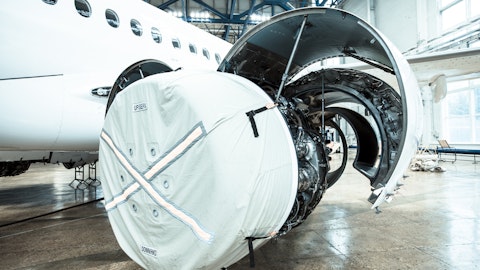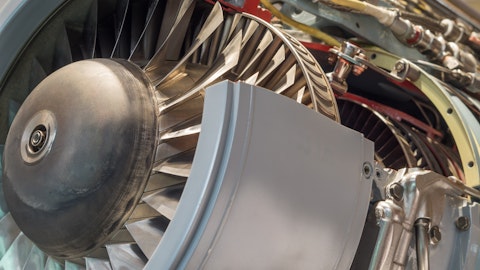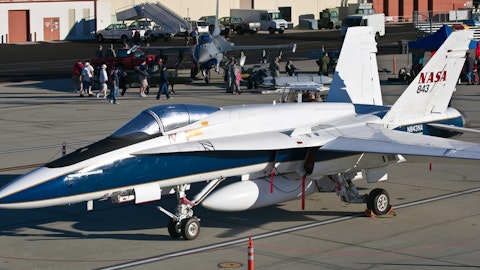Fortress Transportation and Infrastructure Investors LLC (NASDAQ:FTAI) Q3 2023 Earnings Call Transcript October 26, 2023
Operator: Hello, and welcome to FTAI Aviation Third Quarter 2023 Earnings Conference Call. [Operator Instructions]. I would now like to hand the conference over to Alan Andreini, Investor Relations. Sir, you may begin.
Alan Andreini: Thank you. I would like to welcome you all to the FTAI Aviation Third Quarter 2023 Earnings Call. Joining me here today are Joe Adams, our Chief Executive Officer; and Angela Nam, our Chief Financial Officer. We have posted an investor presentation and our press release on our website, which we encourage you to download if you have not already done so. Also, please note that this call is open to the public in listen-only mode and is being webcast. In addition, we will be discussing some non-GAAP financial measures during the call today, including EBITDA. The reconciliation of those measures to the most directly comparable GAAP measures can be found in the earnings supplement. Before I turn the call over to Joe, I would like to point out that certain statements made today will be forward-looking statements, including regarding future earnings.

An aerial view of a commercial jetliner in flight, its airframe glinting in the sun.
These statements by their nature are uncertain and may differ materially from actual results. We encourage you to review the disclaimers in our press release and investor presentation regarding non-GAAP financial measures and forward-looking statements and to review the risk factors contained in our quarterly report filed with the SEC. Now I would like to turn the call over to Joe.
Joseph Adams: Thank you, Alan. To start today, I’m pleased to announce our 34th dividend as a public company and our 49th consecutive dividend since inception. The dividend of $0.30 per share will be paid on November 28, based on a shareholder record date of November 14. Now let’s turn to the numbers. The key metrics for us are adjusted EBITDA. We had another strong quarter with adjusted EBITDA of $154.2 million in Q3 2023, which is up 1% compared to $153.1 million in Q2 of 2023 and up 42% compared to $108.9 million in Q3 2022. During the third quarter, the $154.2 million EBITDA number was comprised of $119.6 million from our Leasing segment, $40.6 million from our Aerospace Products segment and negative $6 million from Corporate and Other.
Turning now to Leasing. Leasing had another good quarter posting approximately $120 million of EBITDA. The pure leasing component of the $120 million of EBITDA came in at $102 million for Q3 versus $94 million in Q2. Additionally, on the acquisition side, we closed on 10 aircraft and 23 engines at attractive prices, which will contribute to further growth in future Leasing EBITDA. Part of the $120 million in EBITDA for Leasing came from gains on asset sales. We sold $55.4 million book value of assets at a 24% margin for a gain of $17.6 million benefiting from strong demand for assets globally. And we’ve had more asset sales coming in the final quarter of this year. Aerospace Products had yet another excellent quarter with $40.6 million of EBITDA and an overall EBITDA margin of 38%.
We sold 41 modules in Q3 to 11 unique customers comprised of 2 new customers and 9 repeat customers. We see tremendous potential in Aerospace Products and feel very good about generating consistent EBITDA growth. As to the balance of 2023, we see FTAI coming in above the high end of the $550 million to $600 million EBITDA range, which we communicated at the beginning of 2023. Looking ahead to 2024, our current expectation is for Leasing EBITDA to total $475 million for the year, including $50 million from gains on asset sales. Based on a strong backlog and an expanding customer base, we are looking for $200 million to $250 million of Aerospace Products EBITDA in 2024, up from $98 million year-to-date 2023 and $70 million in 2022. Overall, we therefore expect annual aviation EBITDA for 2024 to be between $675 million to $725 million, not including Corporate and Other.
With that, I’ll turn the call back to Alan.
Alan Andreini: Thank you, Joe. , you may now open the call to Q&A.
See also 10 Fastest Growing Regions in the World and 12 Best Advertising Stocks To Invest In.
Q&A Session
Follow Ftai Aviation Ltd. (NASDAQ:FTAI)
Follow Ftai Aviation Ltd. (NASDAQ:FTAI)
Receive real-time insider trading and news alerts
Operator: [Operator Instructions]. Our first question comes from the line of Josh Sullivan, which with The Benchmark Company.
Joshua Sullivan: Congratulations on the strong quarter here. Just with the earnings this week, we’ve had some updates from the large aerospace OEMs. Just wanted to check in on what Fortress has seen on the leasing and module market as these new generation of engines face these ongoing [indiscernible] issues. And particularly as it relates to the geared turbofan engine versus the GE56 options Fortress is offering?
Joseph Adams: Yes. So as you can imagine, demand for the prior technology equipment is very, very high in light of what is going to be accelerated maintenance on the new technology and some estimates, the company or others are estimating that approximately 600 A320s with GTF engines on them will be grounded in the first half of 2024 and approximately 300 on average through 2026. So that’s a significant amount of assets that are going to be out of service for an extended period of time. And so anybody that has A320ceos just keeping them and is doing the maintenance to refresh the engine. So both of those are very good for us, and that lease rates are trending up. Almost week to week, you can see increases right now. And so that’s positive and it’s likely going to continue for some time.
And maintenance events, people that we’re estimating they were going to take assets out of service or not do another shop visit or might part them out are delaying and deferring that. So there’ll be more maintenance and assets will last longer. So all of those factors are very, very good for the equipment that we maintain and own.
Joshua Sullivan: Got it. And then secondly, just on the 2024 guidance you provided, what are you baking in for PMA assumptions into that number? And then if we get an approval sooner than later, what does the PMA ramp look like from manufacturing to stocking to actually getting a customer check?
Joseph Adams: Yes, in that $200 million to $250 million number, we’ve included about $15 million to $20 million of EBITDA from PMA. And that would come from both the sale of PMA parts as well as modules. And we’re not sure on the ramp. It’s hard to actually forecast that. So I would assume that most of that is towards the back end of the year is our current assumption.
Operator: [Operator Instructions]. Our next question comes from the line of Myles Walton with Wolfe Research.
Louis Raffetto: It’s Lou Raffetto on for Myles. Maybe just within Aerospace Products, I want to make sure I understand what drove the sequential step-up in sales and EBITDA in the quarter? I mean you did 4 more module swaps, but I’m not sure that equates to the $40 million step-up in sales and obviously, the strong growth in EBITDA as well?
Joseph Adams: Yes. So we also had growth in the sale of used service raw material. So USM was higher and is likely going to continue to grow. As we’ve mentioned previously, we started a number of teardowns in the second quarter, and it generally takes 3 to 6 months for that revenue to show up in EBITDA. So we’re seeing strong demand for USM obviously, with shop visits increasing and that’s 1 key way of saving money on a shop visit. So we see the teardown in used service raw material activity growing. And then within the modules, the mix of modules matters in terms of the revenue and the core has more revenue than the fan and the low-pressure turbine. So it’s — we had more core sales activity in this third quarter than we had in the second quarter.
So it’s proving — that’s exactly what we’ve been expecting and what we’re selling. It’s a harder sell. It’s a longer sell to sell core. It’s easier to do a fan in 2 days or a low-pressure turbine in a week. The core is a little bit more complicated, but we’ve been pitching that for a couple of years now and now we’ve got a lot of customers there recognizing the substantial savings there.
Louis Raffetto: All right. Great. And so just so I’m clear on the USM. So that’s good now. Does that tied at all to the step-up that we saw, I think, a $40 million step-up in the CFM engine parts inventory? Or is it maybe not linked, but just you’re building that inventory to sort of sell? It’s not — again, not necessarily directly linked, but sort of along the same line?
Eun Nam: Yes. This is Angela. As Joe mentioned, the number of teardowns equates to increase of inventory, but you won’t see the revenue generation for 3 to 6 months. So we had a lot of teardowns in Q2, Q3, and you’ll see that revenue come through Q4 and Q1.
Louis Raffetto: Right. So that’s kind of like a — almost look at that as a leading indicator to some extent?
Eun Nam: Yes.
Louis Raffetto: Okay. And then maybe just within Leasing, can you comment on the strong step-up in the maintenance revenue sequentially — year-over-year and sequentially, while the lease income actually did step down sequentially, and I think year-over-year as well?
Joseph Adams: Yes, there’s 2 things went on. One is we elected to terminate 4 A320 aircraft leases to a carrier in Southeast Asia. And we did that to get higher rates and better terms. And so we did that intentionally. There’s such strong demand for these assets, we’ve already got multiple parties that are negotiating to get them. So we had — when you terminate a lease, you have lease maintenance revenues that you recognize from the prior lease come through. So that’s why you see a step up in the maintenance revenue. And then the lease side is a bit of an accounting issue. When we do engine swaps for aircraft that are on lease, we book the difference in value. When you put a new engine on an aircraft and you take an old engine off, there’s generally an increase in the value from the new engine going in.
That gets amortized under the rules, the lease accounting rules as a lease incentive. And so that shows up as — it’s a contra revenue, actually, so it reduces your lease revenue, strangely. But those — that’s why you see it going down. It’s a noncash item, too. So it’s even more confusing from that point of view.
Operator: [Operator Instructions]. Our next question comes from the line of Giuliano Bologna with Compass Point.
Giuliano Bologna: Congratulations on a great quarter.
Joseph Adams: Thanks.
Giuliano Bologna: One thing I’m curious about — asking about is, you obviously mentioned that you’re including $15 million to $20 million of PMA contribution in the products outlook. So there’s obviously some great confidence about being able to receive approval for PMA in the near term. What I was curious about asking kind of with that being said is, do you think the PMA approval timeline could be slowed down at all by the issues the FAA is dealing with? At the moment, there’s [indiscernible] turbofan issues, [indiscernible] parts, government shutdown concerns. I’m just curious how you think about that and how you’re thinking about the impact of PMA approval timeline?



